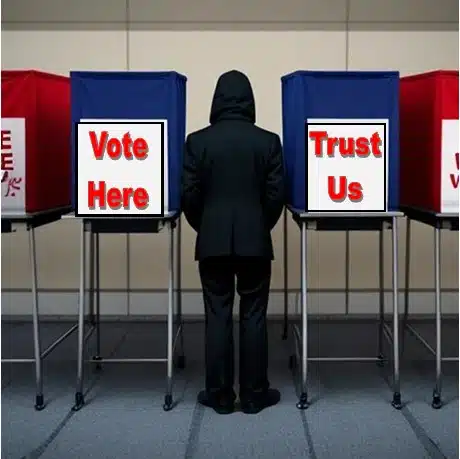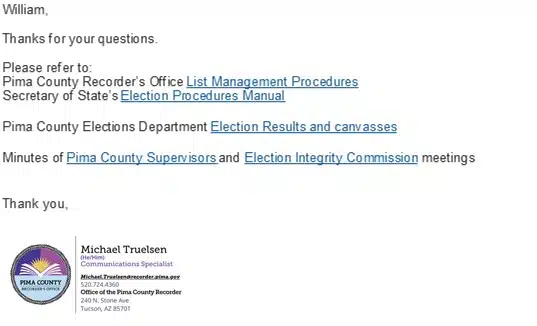
Election Integrity Starts Locally. A Case Study: The Pima County Recorder’s Office, Part Two
In the first part of my series on the Democrat controlled Pima County Recorder’s office, I recounted my experience trying to become a part of the mysterious mail-in ballot signature verification team. If you’ll remember, I was turned down for the job. When I applied, I disclosed I was a journalist working on a story about the election process, which is why they referred me to their media communications department once the interview was over.
I would have preferred firsthand experience learning the ballot handling process, but okay.
I sent an initial query and received a prompt response the next day. Michael Truelson carries the title of “Communications Specialist” in the Recorder’s office and uses the pronouns he/him.
At the time, Truelson asked if we could postpone an interview until after the primary election, which took place the following week. He asked for a list of questions in advance and my availability for an in-person interview.
I had no issue with either request.
A week after the election, I sent another query to Truelson. I attached my questions, and indicated that I would prefer an in-person interview, which would give me the opportunity to ask follow-up questions. In the alternative, written answers would suffice.
Five days later, I sent Truelson another email, expressing a concern that I might have missed his reply.
The following day, I received this:

Gee, thanks, Michael. Giving me links to List Management Procedures (btw: the link is broken), the 385-page Elections Procedures Manual, which I could have downloaded off the website myself, and 14 years of minutes from the Pima County Supervisors meetings wasn’t quite what I was hoping for.
Interestingly, I did read through some of the minutes from the Election Integrity Commission meetings, and I encourage anyone living in Pima County to do the same. Essentially, you will learn that the Commission’s primary mission seems to be ensuring the avenues to cheat remain open or are expanded.
But I digress.
I sent Truelson a follow up email, thanking him for his response but reiterating that I would prefer an interview or, at the least, direct answers to my questions.
From that point on I was ghosted… I never heard from Truelson, Andrea Moreno, or anyone from the Recorder’s Office again.
The Questions
So, what were the actual questions that caused the Recorder’s Office to clam up and give me a cold shoulder? Take a look for yourself:
1) According to the Pima Integrity Project (PIP), 4,289 unqualified votes were counted in the last 5 general elections. This includes 3,153 unqualified votes in 2020. These claims can be found at https://pimaintegrity.com/pima-integrity-project/ (page 5-6).
Question: Does the Pima County Recorder’s Office (PCRO) dispute these statistics? If not, why were these elections certified when the unqualified voters exceeded HAVA standards by 82% in 2020?
2) PIP contends that the TENEX systems used by (PCRO) are not certified (page 9)
Question: How does the PCRO respond to this assertion?
3) According to PIP, the Arizona state legislature appropriated $950,000 in fiscal 2023-24 (HB2862) (page 10) for the express purpose of cleaning up the voter rolls, yet, in PCRO’s expenditure statement (page 11), the entirety of the appropriation was spent on office supplies and temporary help.
Question: Why was the money appropriated for voter roll cleanup spent on non-voter roll expenses?
4) According to PIP, 65,098 voters listed as “active” on the voter rolls haven’t voted since the 2020 election cycle and should have been moved to the “inactive” voter rolls (page 18).
Question: How does the PCRO respond?
5) According to PIP, Pima County has a 92% voter registration rate compared to 69.1% nationally (page 19).
Question: How does the PCRO explain the discrepancy?
6) According to PIP, several 2020 canvas reports appear altered (pages 33-42). PIP claims that only Democrat, Libertarian and Green Party totals appear to be altered.
Question: How does the PCRO respond?
7) According to PIP, In the Recorder’s 2022 General Election Action Report, all early ballot drop-off boxes are to be manned. However, in the PCRO’s early ballot drop-off totals for the 2022 general election, ballots were not picked up on 11/6/2022 and 11/8/2022.
Question: How could the ballot boxes have been manned on those days when they were not picked up?
8) Who created the system for selecting the signature validation team? Since signature validation is the only mechanism available to ensure mail-in ballots are legitimate in Pima County, it seems a bi-partisan team would be more transparent and less suspect than the current method.
Question: Will the PCRO disclose the political affiliation of the current signature team? What would discourage a member of the PCRO’s selection committee from accessing voter registration information for candidates under considerations during the signature verification hiring process? Would you support a change in the methodology for selecting the signature verification team to allow each political party to appoint an identical number of members?
9) According to PIP, there are 230 registered voters at an empty lot at 1000 E 22nd (page 57) and 40 registered voters at a modest midtown residence at 1101 E. Mabel.
Question: How does the PCRO respond?
10) According to PIP, when ballot scanning is complete, the results are transmitted to the PCRO’s servers via an internet connection. PIP also claims that PCRO’s scanners, printers and ePollbooks are internet connected (page 64).
Question: Why are critical elements of PCRO’s voting equipment connected to the internet? What assurance can PCRO provide to the public that these connections cannot be hacked?
11) PIP claims there are 491 active voters in Pima County that are over 100 years old, and 27 that are over 110 years old. (https://pimaintegrity.com/ (part 2: page 11)
Question: How is it that there are individuals on the voter rolls that couldn’t possibly be alive? What does that suggest about the number of other ineligible voters still on the active voter rolls?
12) According to PIP, 8,345 ballots were returned to the recorder for the 2022 general election as undeliverable, but 5,444 of those recipients remain on the active voter rolls (part 2: page 11)
Question: What is the PCRO’s justification for keeping 5,444 voters with undeliverable ballots on the active voter rolls?
13) PIP contends that the chain of command for processing is compromised as there is no documentation to verify the ballots picked up at the USPS by the Recorder’s couriers match the counts received by the ballot processing center. (part 2: page 14)
Question: How does the PCRO respond?
Pima County Voters Deserve Answers
I’m not sure about anyone else, but if I lived in Pima County, issues with ineligible voters, uncertified equipment, misappropriated funds, voters that should have been removed from the voter rolls, altered canvas reports, compromised chain of command, unmanned drop off boxes, dead people on the voter rolls, hundreds of people registered at a single address, and voting equipment connected to the internet would interest me greatly.
Apparently, the Pima County Recorder’s office would prefer to avoid answering these serious questions. They don’t answer to the people because they don’t have to.
During my discussions with Tim Laux, a principal organizer of the Pima Integrity Project, it became very clear early on that my questions only scratch the surface of the numerous election integrity issues in the Recorder’s Office. In particular, ballot chain of custody appears to be inundated with inconsistencies and fraught with opportunities for unauthorized intervention. The largest part of mail-in ballot collection is handled by the local post office. According to the Recorder’s Office, “a team” of staff members retrieves the ballots from the post office and delivers them to the secure ballot room.
What could possibly go wrong between the post office and the ballot room?
While the procedure at the recorder’s office appears secure, requiring two-party verification throughout the process, the question of why the signature verification team is shrouded in secrecy remains unanswered.
What is Happening in Your County?
It’s the same all over the country. Our national elections are decided on a micro level, and each of the 3200+ counties have their own way of doing business. If you want to see more honest and fair elections, take the time to understand how your county addresses voter rolls and processes ballots. In many jurisdictions, a few thousand votes decide whether a state’s electors will go to the Republican candidate or the Democrat.
Leftists know this, and it’s the only explanation why they continually fight tooth and nail to keep the avenues to cheat open.
If you want change, you’re going to have to get involved.



